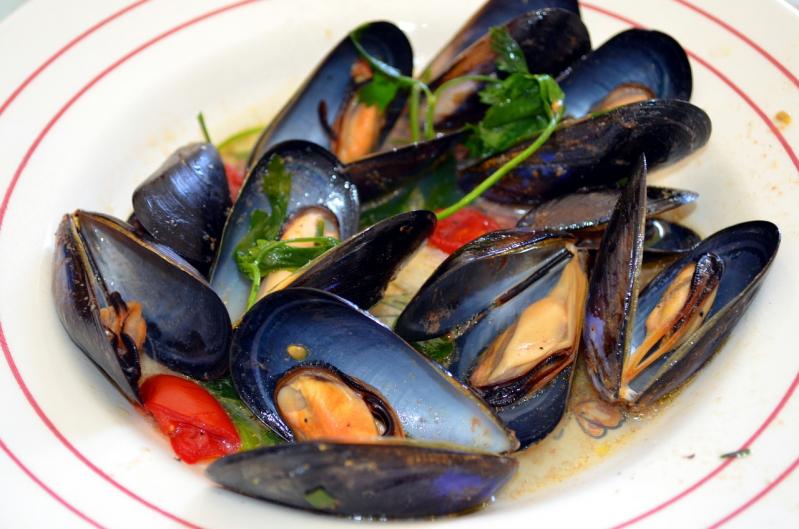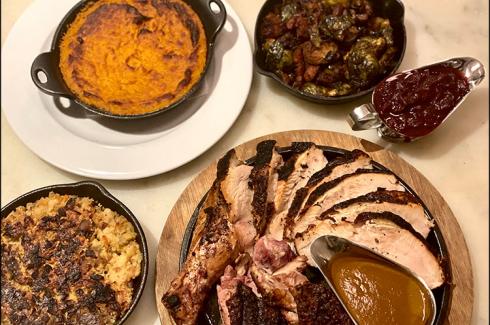Mako shark and bluefish are in good supply and so easy to cook simply by not overcooking them. Mako, once considered a “trash” fish by local fishermen, is similar to swordfish but finer grained and easily dried out; do not attempt to poach or broil it, rather saute it in plenty of butter or olive oil. Young bluefish are best, their fillets broiled under a thick blanket of creme fraiche or plain heavy cream.
Mussels are another local glory found on local menus. At Bobby Van’s, they are served “mariniere” (simply steamed in wine and herbs) year-round. But there are so many ways to serve these cheap, easily cooked shellfish: cold as a first course with various sauces or in soups or hot entrees. Though the Belgians and the French dote on them, mussels are one of our native treasures that seem doomed to neglect by Americans. So here I go. One more time. Another mussel recipe.
Mussels With Chili Mayonnaise
The chilies in this recipe are medium-hot capsicum peppers and have nothing to do with the celebrated Tex-Mex dish. They may be used green, but have a richer flavor when they ripen and turn a brilliant red. I grow these rather large, six-inch-long chilies (their IDs lost before I got the plants) in my garden; you can find similar ones at many farmstands. Medium-hot, they look most like poblanos.
Serves four.
3 lbs. medium-large mussels
1 clove garlic, sliced
1/2 cup dry white wine or Vermouth
The sauce:
2 large, red medium-hot chilies
2 cloves garlic, sliced
Pinch of coarse salt
1 egg (room temperature)
1 cup olive oil, tepid
1/4 tsp. cayenne
2 tsp. lime or lemon juice (approx.)
Wash the mussels and pull out the beards with your fingers and a clam knife. Put them in a large shallow pot with the garlic clove and the wine. Cook over maximum heat, shaking the pan constantly, just until the mussels open. Remove them at once to a tray to prevent further cooking. Slosh a little of their own juices over them and leave them, covered with a tea towel, while you make the sauce for them.
Pierce the stem end of the chili with a long cooking fork. Over direct flame, turning often, toast the chili until it blisters all over — a few black spots won’t hurt. While hot, wrap it in a paper towel for a couple of minutes. Remove it, rub the skin off with a dampened paper towel and running water if necessary. Slit the chili open and remove the seeds, discard the stem. Repeat process with the second chili. The seeds are the source of the real heat; you can dry and save them to use in other dishes. Chop the chilies coarsely and puree them with the garlic and salt in either a blender or a processor. Remove to a small dish.
Put the whole egg in the processor or blender, and gradually dribble in the oil until the mayonnaise starts to thicken. Add the chili puree, then the rest of the oil, the cayenne, and the lime or lemon juice.
Remove the top shells from the mussels, divide them among four plates, and pass the sauce. To use these as a cocktail party hors d’oeuvre, the mussel must be loosened from its bottom shell and masked with a small dab of the sauce. Provide a “debris” bowl for the shells.
This sauce, wonderful on any kind of cooked shellfish, occurred to me as I was reading about rouille, the spicy red sauce that goes into Provencal fish stews. It is sort of a cross between that and the other famous sauce of Provence, aioli. This pale pink spicy mayonnaise would be an entertaining departure for the usual platter of crudites.
Glorious Vegetables
Recently a friend confided to me that she and her husband planned to live on corn and tomatoes until summer’s end. Aside from the glory of the two vegetables at their most basic, the first boiled, the second sliced raw, there are all sorts of sauces, soups, souffles, and breads to be made of our luxurious surfeit. (Cooking with vine-ripened tomatoes still strikes me as wanton extravagance, which is why I enjoy doing it so much.)
Tomatoes: These should be picked when they are red and twist easily from their vine. Store them, not touching, on a layer of soft paper towels spread in a shallow basket. Keep the basket in an airy, dim place — never in the sun. Underripe tomatoes ripen best in a brown paper bag with some air holes punched in it. Placing tomatoes on sunny windowsills simply heats them up and dissipates their flavor. Never put tomatoes in the refrigerator. (I realize that the home gardener sometimes has no choice when there is a sudden glut of ripe tomatoes, but they can last at room temperature, if the weather isn’t just beastly, up to five days even if picked very ripe.) Never add sugar to recipes that include fresh ripe tomatoes. Good tomatoes are sweet to begin with. 1 don’t know where all that “pinch of sugar” nonsense began.
Corn: Mark Twain, a man who knew his victuals, said that the only way to fix corn was to boil a pot of water in the field and shuck the ears into it (according to “The Taste of America,” John and Karen Hess, 1977). Since the local farmers do such a bang-up job of growing many varieties of superior corn, not many of us care to plant it. Get to your favorite farmstand early in the day or for the late afternoon picking. Take a big Styrofoam hamper with some ice or a plastic “blue ice” square to keep the corn cool. Heat is the enemy of corn; it should be kept out of the sun (never buy from a pile of corn that is lying in the sun) and refrigerated until the moment it is to be cooked. Start boiling the water before you start shucking the corn. Add nothing, NO NOT NOTHING, not milk, sugar, or salt, to the water. Great big ears of yellow corn, while some people prefer them, tend to be rather starchy and tough. I prefer slender ears and pale, small kernels. They can be white, gold, or a mix of the two.





